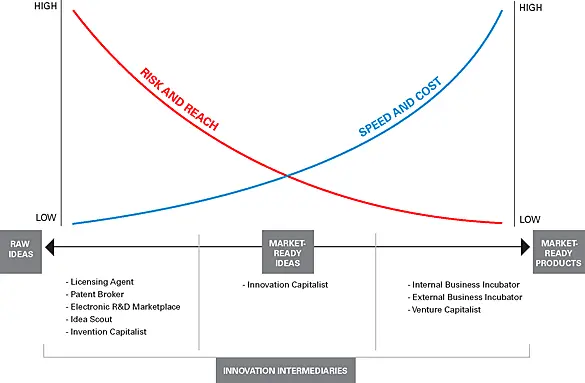
In 2021, international patent filings experienced a yearly growth of 0.9%, reaching 278 million. Specifically focusing on the United States, the period since the beginning of the pandemic witnessed a remarkable surge in new business formations. After the notable year of 2020, applications from employers likely to hire hit a record 1.8 million in 2021 – marking the highest annual figure to date. In 2022, the trend continued with 1.7 million applications, constituting the second-largest annual total on record and reflecting an almost 30% rise from the pre-pandemic baseline.
Recognizing potential of independent and small company inventors
The landscape of innovation is often dominated by the narrative of major corporations and iconic inventors, overshadowing the critical contributions of lesser-known inventors and the patents they hold. These invisible inventors, frequently operating from independent backgrounds or within small companies, play a significant role in driving industry change. Their inventions, while may not always be at the forefront of media attention, often lay the groundwork for significant technological shifts and market evolutions. The significance of recognizing and supporting these inventors cannot be overstated, as their work often introduces novel solutions to complex problems, challenges existing paradigms, and contributes to the diversification of technological advancements.
The potential of these inventors and their patents in shaping industries is evident through numerous historical and contemporary examples where a single patent has catalyzed industry-wide transformation. Independent and small company inventors often pursue innovation out of a genuine desire to solve real-world problems, untethered by the constraints that can sometimes stifle creativity within larger organizations. This freedom allows for the exploration of unconventional ideas, leading to breakthroughs that can redefine markets. Moreover, their contributions are essential for fostering competition, encouraging diversity in innovation, and promoting a more inclusive ecosystem where a wider range of ideas can flourish.
Individual inventors in the United States held the majority of patents until 1933, accounting for nearly 50 percent of all patents issued until 1950. Following this period, corporate entities began to dominate the patent landscape, surpassing individual inventors after 1950. Despite this shift, individual inventors consistently maintained a substantial output, generating between 10,000 to 15,000 patents annually. The first half of the twentieth century witnessed a prolonged transitional phase where relatively unknown independent inventors, such as Samuel Ruben (known for Duracell batteries), Garrett A. Morgan (inventor of the gas mask), Marion O’Brien Donovan (creator of the leak proof diaper cover), and Earl S. Tupper (famous for Tupperware), made significant contributions to the field with their notable inventions.
A vast array of offerings spans from conceptual ideas and patents to fully developed market-ready products. Various promoters, including idea scouts and business incubators, enthusiastically endorse these offerings. Simply considering entering the bustling and dynamic realm of this industry can be overwhelming.
The Potential of Lesser-Known Patents
In 2014, the U.S. Patent and Trademark Office granted just 6% of all patents to independent inventors, according to Dennis Crouch (2015). To inspire individual inventors to submit more patent applications, many patent offices worldwide have implemented reduced fees for these inventors.
Sir James Dyson, an independent inventor, revolutionized the vacuum cleaner industry with his bagless cyclonic separation technology. This innovation not only transformed the way vacuum cleaners function but also led to the development of other successful products under the Dyson brand. This case underscores how a single innovative idea from an independent inventor can reshape an entire industry and create a domino effect of advancements.
The development of Post-it Notes stemmed from a failed attempt to create a strong adhesive. Spencer Silver, a chemist at 3M, discovered a low-tack adhesive that became the foundation for the creation of this iconic product. Despite initial skepticism, Post-it Notes became a global success.
Qualcomm, initially a small company, played a pivotal role in the development of Code Division Multiple Access (CDMA) technology, a key innovation in mobile communications. CDMA became the basis for 3G and 4G technologies, shaping the modern wireless industry.
Challenges Faced by Independent Inventors
Lack of resources and funding
Small technology firms in the United States employ 38% of the nation’s scientists and engineers, with a significant focus on industrial professionals (54.8% of the total). Despite their substantial workforce, these nearly 6 million individuals only receive a modest 4.3% of government research and development (R&D) funding. On the other hand, larger companies with over 500 employees, constituting 27% of the scientific and engineering workforce, receive a more substantial share of government R&D funds at 50.3%.
In comparison, universities employ 16% of scientists and engineers but secure a notable 35.3% of government R&D funding. Non-profit research institutions receive 9.1% of R&D funding, while states and foreign countries collectively obtain 1.0% of the total R&D funds. This distribution highlights disparities in funding allocation among different entities involved in scientific and engineering research.
Patent Litigation
The public perception of patents has shifted from associations with innovation and inventors to primarily lawsuits. This portrays a supposed “explosion” of patent litigation, diverting attention from these companies’ practices of utilizing others’ inventions without fair compensation, known as “efficient infringement.”
However, the verifiable facts contradict this narrative. According to legal analytics firm Lex Machina, patent infringement suits actually declined by 22% in 2016. While there was a notable increase in patent litigation around 2012-2013, this coincided with changes in joinder rules, not an actual surge in disputes. The rise in patent suits is largely correlated with the growth in granted patents, with no evidence of speculative abuse.
High Cost of Patenting
The expenses associated with patent filing, maintenance, and legal support pose significant barriers for small inventors.
A report from the United States Patent and Trademark Office (USPTO) highlights the financial burden of obtaining and protecting patents, especially for individuals and small enterprises.
Buying from Independent Innovators
The evolving landscape of innovation acquisition (patents acquisition) presents a compelling case for companies to diversify their sourcing strategies beyond traditional models, advocating for a more inclusive approach that recognizes the value of buying from independent innovators and small companies. This strategy underscores the importance of a balanced approach to innovation sourcing, which requires a careful assessment of the industry or market profile alongside a company’s internal capabilities for innovation. By exploring various points along the innovation sourcing continuum, companies can achieve a dynamic blend of flexibility and strategic foresight. This methodology allows them to effectively navigate the innovation market, yielding a rich diversity of innovative solutions that can significantly enhance competitive advantage and drive industry change.
Central to this balanced approach is the concept of collaborating with “innovation capitalists”—a novel intermediary that bridges the gap between independent innovators and larger corporations seeking market-ready ideas. Innovation capitalists facilitate a three-stage process: identifying and evaluating promising ideas, developing and refining selected concepts, and ultimately, delivering fully developed products to companies. This model optimizes reach, cost, risk, and speed by mitigating the inherent risks associated with early-stage innovation and accelerating the time to market, all without substantially increasing acquisition costs. Engaging with innovation capitalists necessitates building long-term relationships founded on trust, collaboration, and clear communication, ensuring that the goals and priorities of the client company are fully aligned with the innovative solutions provided. By integrating the strengths of independent innovators through such intermediaries, companies can significantly enhance their innovation portfolios, fostering a more vibrant, competitive, and forward-looking industry landscape.
For “innovation capitalists” or corporations keen on acquiring patents and innovations from smaller entities or independent inventors, which possess significant growth potential yet remain largely undiscovered, Intellectual Frontiers offers a streamlined platform through its patents marketplace. We invite you to explore our recently listed patents for sale and licensing at Intellectual Frontiers, featuring inventions from independent inventors—true hidden gems in the realm of innovation.

